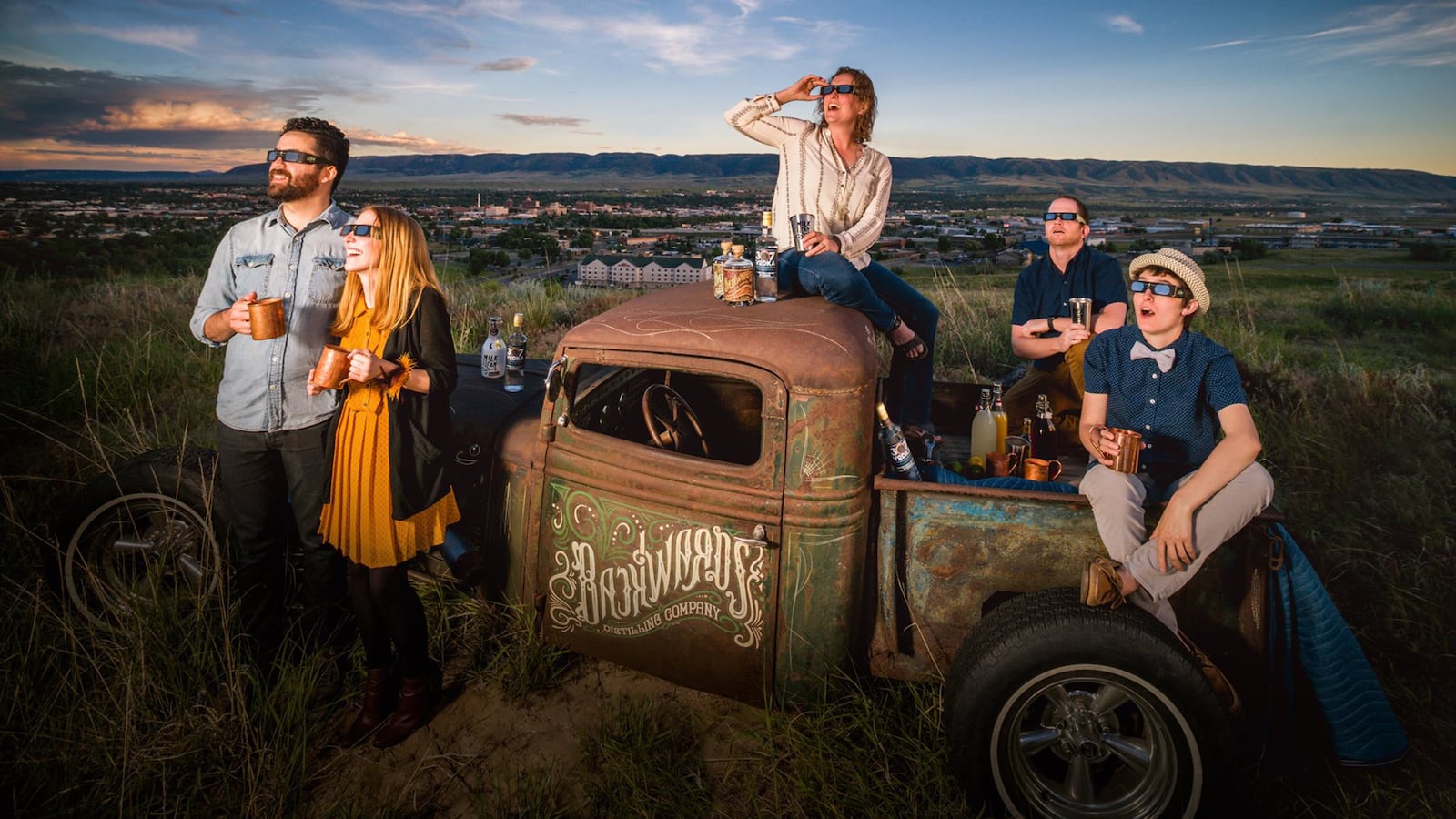Next Monday, sky watchers from the beaches of Oregon through the midsection of America and down the South Carolina coastline, will be trying to catch a glimpse of the first total solar eclipse across the U.S. in 99 years. But in the so-called path of totality—a 70-or-so-mile-wide band in which parts of the country will be in complete daytime darkness for two-plus minutes—bartenders, winemakers, and distillers are hoping for another cosmic call: “Another round, please!”
Here’s how five distillers, winemakers, and brewers are prepping for when the sun suddenly goes dark.
MADRAS, OREGON—Totality Strikes: 10:19 a.m. PDT
When it comes to claims to fame, tiny Madras, Oregon (pop: roughly 6,700), usually boasts about being America’s carrot seed capital. But on eclipse day, Madras becomes a prime viewing spot in the state where the eclipse first strikes U.S. soil. More than 100,000 people are expected to cram into the central Oregon high-desert town for the event, attracted by wide-open vistas, predictably clear summer skies, and 2 minutes, 2 seconds of total darkness, one of the longest spans in the Northwest.
Rick Molitor has something else waiting for them: American Strong’er, a 97-proof whiskey he has distilled specially for eclipse day. Two years ago, Molitor, along with four drinking buddies, opened New Basin and came out with American Strong Light, a whiskey named after Jedediah Strong Smith, an early Western settler. For the Strong’er version, he tweaked the final product, upping the proof from 80 to 97. Why 97? It’s a nod to Highway 97, which bisects Madras and will lead many an eclipse watcher into town for the moon show—and ideally to his distillery.
In the days leading up to the eclipse Madras will stage Solarfest, a county fair-like celebration featuring 20 bands, balloon rides, and NASA scientists holding court for the thousands of campers slated to hit town. Molitor is also hosting a VIP breakfast that day for about 50 guests. They’ll first get to see his 300-gallon still, and then sit back and view the eclipse without having to compete with the throngs for a spot. He’s also thinking of using the three hours it takes for the moon to pass by the sun to keep his still running. “If we do a small batch and get it just dialed,” he says, “I’ll be able to claim that it was made during the eclipse.”
CASPER, WYOMING—Totality Strikes: 11:42 a.m. MDT
Amber Pollock says her hometown of Casper, Wyoming, has long been viewed as “a beer-drinking town.” Come eclipse day, she’s seeking to change that perception—if not forever then at least for the time it takes for midday darkness to come and go.
She’s hosting an all-day watch party at her family-owned Backwards Distilling Company, and during two-hour blocks, Pollock will serve cocktails named after the evolving sky. For instance, starting at 9 a.m., there’s the Eclipse Chaser—cold-brewed coffee and fresh-squeezed orange juice, with muddled blueberries, tiki bitters, and an optional shot of Backwards’ own Sword Swallower Rum. Then, around 11 a.m., shortly after the moon first starts shading the sun, Pollock will offer up the First Contact: house-made pineapple lemonade, house-made grenadine, and 307 Eclipse Edition Vodka, a special version of the spirit that helped launch her family’s distillery two-and-a-half years ago.
Named after Wyoming’s sole area code, the 307 Vodka was developed by Pollock’s younger brother, Chad. “There were a lot of places serving Jack & Cokes [in Casper], but not many where you were going to find fresh squeezed juice,” says Pollock, a former elementary school teacher who launched Backwards with her brother and parents in 2014. “We had to open a facility to showcase our products in a way we wanted them to be showcased.”
Backwards, Casper’s only spirits distillery, has a tasting area that seats 52. Pollock hopes to double that number on eclipse day, drawing from the 35,000 visitors the city is expecting. (Total eclipse time in Casper: 2 minute, 26 seconds.) Besides offering unobstructed views from the distillery’s site, located on an elevated space away from downtown, Pollock has booked Inda Eaton, a Long Island-based singer-songwriter who grew up in Casper, to perform. Eaton goes on once the sun returns, and once Pollock’s last eclipse-day concoction—the Corona, a mix of milk can cinnamon moonshine, pineapple juice, lemon juice, vanilla, and bitters—is making the rounds.
MAKANDA, ILLINOIS—Totality Strikes: 1:20 p.m. CDT
Back in 2014, Jim Ewers, who owns and operates Blue Sky Vineyard in Makanda, got a call from a stargazing junkie in Germany. The caller wanted to know if she could book a room at Ewers’ winery—for August 2017. Before that reservation request, Ewers had no clue about the coming eclipse, and that his vineyard was prime real estate for eclipse chasers. “I basically added 50 percent to the price I was charging at the time,” recalls Ewers, whose winery includes a few guest rooms. “She never took it, which worked out well because I’ve since gotten more [for the room].”
If the moon and sun line up according to star experts’ predictions, then Makanda is considered Ground Zero; total darkness in the southern Illinois town (pop: 544) is slated to last 2 minutes, 40.2 seconds, the longest duration of darkness in the country. Ewers plans to take full advantage of the designation. He’s expecting 3,000 to 5,000 people to make use of his 600-acre vineyard in the Shawnee Hills region of southern Illinois. (Ewers is charging $100 a night for RV campers.) He also bottled 100 cases of Solar Eclipse Wine, a specially made dry and, befitting the day, dark red wine he hopes to sell out by the time the crowds leave. The wine is a blend of two grapes grown in Ewers’ vineyard: Champbourcin, a French-American hybrid that Ewers says is low in tannin and fairly fruity, and Norton, a dark grape. “You can crush it and you get a high percentage of skin to juice,” Ewers explains. “You can extract more color out of the skin so you get a nice rich color out of it.”
Along with pushing the wine, Ewers has used the final days before the eclipse to map out where the rush of RVs will park, where to put a group of stargazing enthusiasts from Spain so they have a bit of seclusion and where to mount a specially commissioned piece of abstract artwork— aptly titled “He Flew Too Close to the Sun”—near the winery. The pace has left Ewers to admit, “I can’t wait until the 22nd. I want it all behind me.”
Perhaps, but he also knows what lies ahead. Come April 8, 2024, when the next total solar eclipse is slated for the U.S., his vineyard once again will be in the path of totality.
HOPKINSVILLE, KENTUCKY—Totality Strikes: 1:24 p.m. CDT
Peg Hays has been aware of the approaching eclipse for 10 years, even before she and her husband, AJ Jones, bought land in Hopkinsville and decided to open the Casey Jones Distillery on it. She’s watched dozens of clips of past eclipses on YouTube. She jokingly calls herself the “Empress of the Eclipse.”
So, when darkness strikes on Aug. 21, she’ll be ready. Totality, she says, is “at 1:24 pm Central Daylight Time, for 2:40 seconds. At 1:20 I’m going to go to the bathroom; I have that on my calendar already. Then I’m going to get outside and be with the crowd and watch it, let everything else go to hell, and watch this eclipse.”

A couple of weeks before the big day, Hays isn’t sure if the crowd camping out on her property will be “500 or 5,000.” Doesn’t matter. She’s hosting a three-day party featuring blue-grass bands, food trucks, and a barber giving E-clips.
And, no doubt, she’ll be pouring her distillery’s Total Eclipse Moonshine, made from yellow dent corn that’s locally grown. “We are Kentucky proud,” she boasts, then jokes: “You can have a total or partial eclipse right now by opening up a bottle.”
The trademarked 100-proof spirit comes from a still that’s a duplicate of the last one built by Casey Jones, a Prohibition-era still maker and AJ’s grandfather. “This region [western Kentucky] was known during Prohibition as a great place to get great moonshine product,” says Hays, who began distilling on her property with AJ two years ago.
Hays has already sold more than 5,000 bottles of the special moonshine. During eclipse weekend, she expects to sell a few more. That’s because Hopkinsville, with 32,000 residents, is gearing up for 200,000 sightseers, scientists, and, well, party-chasers to come for eclipse weekend. Hopkinsville even rebranded itself “Eclipseville” thanks to researchers determining it’s where the Point of Greatest Eclipse will occur—or “where the width of the moon’s shadow is widest,” according to Solar.com. (Darkness in Hopkinsville will be just .1 second shorter than in Makanda.)
But come totality time don’t expect Hays to be behind the counter. “In fact,” she says, “when we hand out parking passes, we’re going to tell people that at 1 p.m. we’re locking up the distillery and letting everyone experience the eclipse, including our staff.” She pauses, then, with a laugh, says, “Last call.”
COLUMBIA, SOUTH CAROLINA—Totality Strikes: 2:41 p.m. EDT
Speaking of last call… Two years ago, when Bryan O’Neal heard that his home state, South Carolina, would be the end of the line for Eclipse 2017, it got him thinking. And then, when he heard about the estimated number of out-of-state visitors the eclipse would draw to the state capital, Columbia, located 50 miles south of his brewery, it really got him thinking. He told himself, “If there’s going to be a million people, we’re going to brew a beer for this. This is a once-in-a hundred-year opportunity.”
O’Neal, who built swimming pools for 22 years before opening Benford Brewing on his cattle farm in Lancaster four years ago, quickly got to work. Wanting an “extremely dark” IPA for the day, he tweaked one of his recipes by using midnight wheat. “So it has a hint of porter at the beginning,” says O’Neal, “and then the hops explode with Mosaic, El Dorado, and Citra.” He called it Carolina Blackout and had a specially designed label prepared for it, using a variation of the state symbol—a Palmetto tree with a crescent moon—by switching in an eclipse moon. He included the date, Aug. 21, 2017.

And he trademarked Carolina Blackout. By starting early, he says, “we would beat all the other brewers to the punch and own the eclipse. And this is what pretty much happened.” Fortunately for O’Neal, the path of totality in South Carolina includes Columbia, Clemson, and Charleston, locations of many of his retailers. “It’s going to be like St. Patrick’s Day,” says O’Neal. “In the week of the eclipse they are going to want [Carolina Blackout] like they want green beer.”
On eclipse day, O’Neal will head to Columbia to watch the moon at work from a friend’s rooftop terrace, have a Blackout (or two), and revel in a once-in-a-lifetime sight. “South Carolina is home, and I am proud of my state,” says O’Neal. “The fact that we are getting this attention nationally is a good opportunity for the brewery and the state. It’s going to be a pretty special day.”






